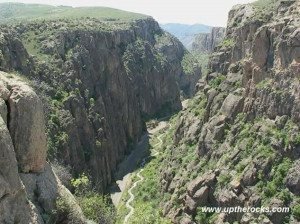(A.W.)—Armenia’s got rocks, and it so happens, they are the latest attraction for the type of tourist that lives for a climbing high. Globe-trotting climbers travel to Armenia chiefly to climb up its majestic rock formations. They come with high hopes, and leave still wanting more.

Sam Bié, a French rock-climbing photographer is one such adventurer. He first heard about Armenia’s terrain from a small news story on a Russian website announcing the opening of the first-ever rock climbing event in Armenia—the “Arev” Armenian First Ascent Open Festival.
The festival, now held annually in May, was organized by Up the Rocks, a group founded in 2008 by rock-climbing enthusiast Mkhitar Mkhitaryan, who has worked toward developing the sport in the country and promoting it in the international rock-climbing community.
The article “talked about a small gathering organized by Mkhitar Mkhitaryan and his association… So, after browsing through the photos posted on the website, and by searching Google Earth, I said to myself that these ‘organs’ made of basalt must be even more extraordinary in person—or at least, that’s what we hoped,” Bié told the Armenian Weekly.
The “organs” he was referring to are vertical and steep hexagonal basalt columns in Garni Gorge, which resemble a pipe organ. Sprayed with moss and vegetation, they are an impressive sight.
Bié shared his new find with champion climber Alex Chabot, the winner of around two dozen World Cup titles. “I mentioned it to only Alex…with whom I had traveled previously. It’s the sort of destination he appreciates,” noted Bié. Soon thereafter, the pair began planning their trip to Armenia and invited a third climber, Pippa Planques, to join.
The following year, they reached Armenia via Lebanon. “We first went exploring, routing, and climbing in Lebanon, and from there, we went to Armenia,” said Bié.
“Why [did we pick] Armenia? Because we are part of a group of climbers who is always searching for new cliffs in the world, the most beautiful and unknown that are yet to be discovered. We search for that rare pearl!” added Bié.
Among their destinations were the Noravank canyon, the Arpa Gorge, and the Garni Gorge. The latter two are protected sites where pitons and bolts may not be used—challenging skilled clean climbers.
Bié was soon struck by the unique beauty of Armenia’s terrain. “The aesthetic appeal of these ‘organs’ are unparalleled!” he said. “Climbers love beautiful and unique rocks, just as surfers love a magnificent, well formed wave of translucent water. It’s always better than a small foamy wave of brownish hue.”

On the “organs,” the climbers use special movable anchors that wedge between cracks and don’t harm the rocks. “The ‘organs’ are a little more dangerous [than the Noravank cliffs]. We climb with two ropes since the rocks are pretty steep. We are never safe from pulling on a huge rock that could have us fall, and all this by being protected from the fall strictly by anchors,” said Bié.
The team mapped new climbing trails—referred to as “new-routing” in climbing lingo. In Noravank, as one of the first climbers to scale the limestone cliffs, Bié and Chabot faced the added challenge of “cleaning” a “modern” 150-meter-high rock, which involved removing loose rocks on their path.
“‘Modern’ because the equipment we put in place is anchored inside the rock, so there is no need to place mobile pincers like we did on the ‘organs.’ And removing chunks of unstable rock is simply to make it less dangerous to climb inside, both for us and for future climbers,” explained Bié.
Lately, the Noravank area has received much international attention, ever since the oldest known shoe and wine-making facility were discovered in a nearby cave, outside the village of Areni.
Bié says he’s likely to return to Armenia. “There is still much to be done because, during our journey, we didn’t have good weather,” he said.
Soon after the trip, the story was published in Rock and Ice, a magazine dedicated to the sport. “The world’s greatest, untapped rock is in Armenia, a place you likely can’t even find on a map,” it declared enthusiastically in a feature article titled “Amazing Armenia.”
Using Bié’s photographs, Rock and Ice prepared a clip in which the magazine’s Jeff Jackson eloquently described the scenery. “Six-sided columns ran up basalt ramparts like a stack of Grecian pillars. A dike of perfect gold stairs split a strange, 300-foot tower of gray choss. Snowy mountains with slopes of varicolored grasses fell precipitously to orchards, sedge and clear rivers. Gorges of volcanic rock were cloaked in fog… It looked like the best trad climbing area in the world,” admired Jackson.
http://www.youtube.com/watch?v=ClzfbIaGHxYBié and Chabot’s beautifully documented trip to Armenia introduced the country to the rock-climbing world, placing Armenia on a destination wish list of many world adventurers.
Aside from Garni Gorge, Arpa Gorge, and Noravank canyon, the Hrazdan Gorge and the Ijevan mountain range have also attracted climbers.
Meanwhile, the 2011 Arev Festival is fast approaching, and climbers will soon flock to Armenia to experience its amazing terrain, and unique culture.
Note: The Weekly contacted Mkhitarian for an interview, but he politely declined, noting that he only gives interviews to publications dedicated to the sport.


Be the first to comment